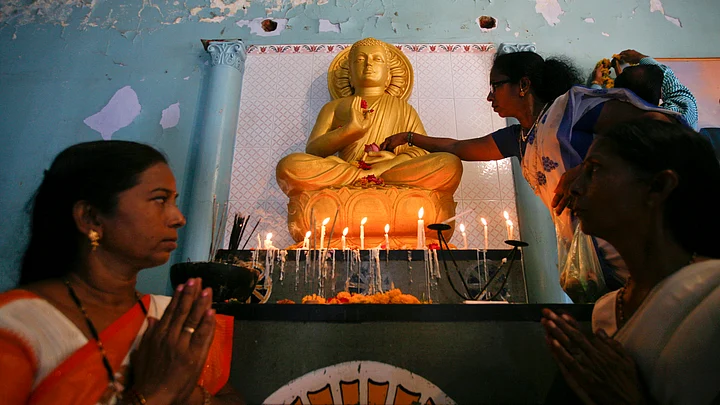For the spiritually inclined or simply those looking for inner peace and happiness, today is as good as it gets.
Monday, 4th May is Buddha Purnima. Celebrated and revered by millions across the world it is not just the birthday of Lord Buddha, but the day when Siddharta Gautama Shakyamuni Buddha attained enlightenment and the day he passed away from this world.
Generally celebrated on the first full-moon night in the month of Vaisakh (Wesak), the actual date varies from country to country depending on the specific Asian luni-solar calendar they follow.
For all believers -- especially those practising the Theravada school of Buddhism -- this triple confluence of Birth, Nirvana and Parinirvana (Death) makes the day especially powerful and auspicious.
Buddhists across south-east Asia throng temples and monasteries.
“On Vesakha
day, devout Buddhists and followers alike are expected and requested to assemble
in their various temples before dawn for the ceremonial, and honourable,
hoisting of the Buddhist flag and the singing of hymns in praise of the holy
triple gem: the Buddha, the Dharma (his teachings), and the Sangha (his
disciples). Devotees may bring simple offerings of flowers, candles and
joss-sticks to lay at the feet of their teacher,” elaborates Wikipedia.
Bathing the Buddha is an important ceremony. The Buddha idol is bathed in water
in a symbolic reminder for devotees to purify their minds of greed, hatred and
ignorance. Gifts are also offered and caged birds and animals are released as a
mark of the letting go of troubles and worries. All the ceremonies are
accompanied by chanting and praying.
Generally Lord Buddha’s birthplace Lumbini, 200 kms from Kathmandu which houses the Mayadevi temple and the sacred Bodhi tree is a pilgrimage spot thronged by international devotees. However as per reports, the recent quake has damaged the spot.
In fact Swayambhunath, a fifth-century stupa where thousands congregate on Buddha Purnima to offer prayers will keep its doors closed as the temple has been extensively damaged by the quake.
The impact of full moons on humans and the cosmic energies transferred is well
documented in Hindu rituals and lore. There are special nights for prayers,
fasting and holy dips. For many Buddhists across south east Asia, Wesak night
when the moon is in the constellation of Taurus (or Vaishakha in Sanskrit) is
supremely primed for spiritual cleansing and new beginnings.
Incidentally as per Hindu mythology Lord Buddha is considered the 9th
incarnation of Lord Vishnu.
It is estimated that meditating during the full moon is equivalent to meditating for several weeks. To meditate during the Wesak Full Moon is equivalent to meditating continuously for several months!
Practicing the Meditation on Twin Hearts and the Great Invocation with 7 people is equivalent to over 100 people doing meditation independently. With 1000 or more, like-minded spiritual disciples meditating simultaneously the effect is beyond comprehension says the World Pranic Healing Foundation.
New Age advocates say the flow of spiritual energy reaches a peak during this full moon period. Some like the Lucis Trust say today is the ‘high-water of spiritual blessing in the world’ and have organised a ceremony, Wesak Festival in the Himalayas.
(At The Quint, we question everything. Play an active role in shaping our journalism by becoming a member today.)
